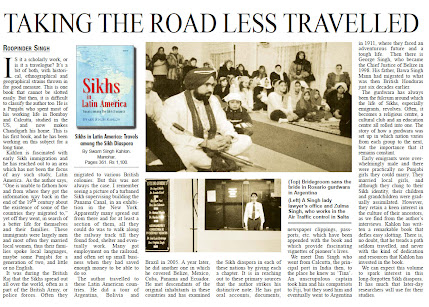
By Swarn Singh Kahlon. Manohar. Pages 361. Rs 1,100.
Reviewed by Roopinder Singh
IS it a scholarly work, or is it a travelogue? It’s a bit of both, with historical, ethnographical and geographical strains thrown in for good measure. This is one book that cannot be slotted easily. But then, it is difficult to classify the author too. He is a Punjabi who spent most of his working life in Bombay and Calcutta, studied in the US, and now makes Chandigarh his home. This is his first book, and he has been working on this subject for a long time.
Kahlon is fascinated with early Sikh immigration and he has reached out to an area which has not been the focus of any such study, Latin America. As the author says, “One is unable to fathom how and from where they got the information way back in the end of the 19th century about the existence of some of the countries they migrated to,” yet off they went, in search of a better life for themselves and their families. These immigrants were largely men and most often they married local women, thus their families spoke local languages, maybe some Punjabi for a generation of two, and little or no English.
It was during the British Raj that the Sikhs spread out all over the world, often as a part of the British Army, or police forces. Often they migrated to various British colonies. But this was not always the case. I remember seeing a picture of a turbaned Sikh supervising building the Panama Canal, in an exhibition in the New York. Apparently many spread out from there and for at least a section of them, all they could do was to walk along the railway track till they found food, shelter and eventually work. Many got employment on the railroad, and often set up small business when they had saved enough money to be able to do so.
The author travelled to these Latin American countries. He did a tour of Argentina, Bolivia and Brazil in 2005. A year later, he did another one in which he covered Belize, Mexico, Cuba, Panama and Ecuador. He met descendants of the original inhabitants in these countries and has examined the Sikh diaspora in each of these nations by giving each a chapter. It is in reaching out to these primary sources that the author strikes his distinctive note. He has got oral accounts, documents, newspaper clippings, passports, etc. which have been appended with the book and which provide fascinating vignettes of pioneer’s lives.
We meet Dan Singh who went from Calcutta, the principal port in India then, to the place he knew as ‘Tina’. An unscrupulous captain took him and his compatriots to Fiji, but they sued him and eventually went to Argentina in 1911, where they faced an adventurous future and a tough life. Then there is George Singh, who became the Chief Justice of Belize in 1998. His father, Bawa Singh Mann had migrated to what was then British Honduras just six decades earlier.
The gurdwara has always been the fulcrum around which the life of Sikhs, especially emigrants, revolves. Often, it becomes a religious centre, a cultural club and an education centre all rolled into one. The story of how a gurdwara was set up in which nation varies from each group to the next, but the importance that it remains constant.
Early emigrants were overwhelmingly male and there were practically no Punjabi girls they could marry. They married local girls, and although they clung to their Sikh identity, their children and grandchildren were gradually assimilated. However, they retain a keen interest in the culture of their ancestors, as we find from the author’s interviews. Kahlon has written a remarkable book that defies easy slotting. There is, no doubt, that he treads a path seldom travelled, and never with the kind of dedication and resources that Kahlon has invested in the book.
We can expect this volume to spark interest in this long-forgotten Sikh diaspora. It has much that later-day researchers will use for their studies.
This review was published in the Spectrum magazine section of The Tribune on Sunday, April 22, 2012.
